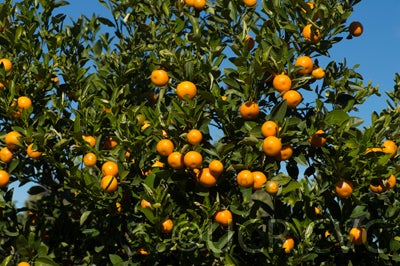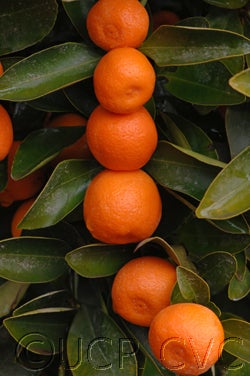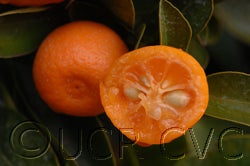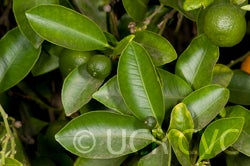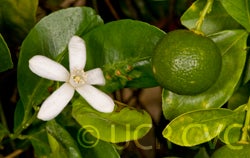X Citrofortunella microcarpa (Bunge) Wijnands
Citrus madurensis Lour.
CRC 2592
PI 539349
VI 408
Source
Received as a seedling from USDA, Washington, D.C., via Walter Swingle, 1935.
Parentage/origins
Parents unknown. It is believed to be a natural hybrid, with kumquat in the parentage.
Rootstocks of accession
Own root.
Season of ripeness at Riverside
Year-round
Notes and observations
Calamondin Citrus madurensis is an acid fruit that is most commonly grown in the Philippine Islands although it is probably of Chinese origin. It is believed to be a natural hybrid, with kumquat in the parentage. In the Philippines it is sometimes called calamonding or calamansi. Here in the United States it is primarily planted as an ornamental, either growing in the ground or in a container. Calamondin is cold-resistant. The tree form is upright and columnar, and the leaves are small and dense giving the tree a fine textural appearance. The fruits are very small, round, and orange at full maturity. The orange flesh is acidic, juicy, and contains a few seeds. Calamondin trees flower and set fruit intermittently throughout the year, adding to the decorative appeal of these trees. A variegated form, with marbled leaves and faintly-striped fruit is sometimes marketed under the name Peters.
WPB: Dr. Hu, in 1951, said that Chi Chieh is sechi chieh- which means four season.
Torres, Remuel (02/28/2019): ".....in the Philippines, we have a growing industry in terms of manufacturing and processing of calamansi fruit juice and other related products. I felt like this might be quite important to raise since it might be that people from (the United States) who are propagating this plant, mainly for ornamental value, may be missing some of its other good uses. " (see: http://www.asiadhrra.org/activityblogs/1stLSFMForum/wkit/Value%20Chain%20Analysis%20of%20Calamansi.pdf. )
Description from The Citrus Industry Vol. 1 (1967)
"Fruit very small, oblate to spherical; apex flattened or depressed. Rind color orange to orange-red; very thin, smooth, and finely pitted, easily separable only at maturity; sweet and edible. Segments about 9 and axis small and semi-hollow. Flesh orange-colored; tender, juicy, and acid. Seeds few, small, plump, polyembryonic, and with green cotyledons. Fruit holds on tree remarkably well.
Tree of medium vigor, highly productive, upright and columnar, nearly thornless; leaves small, broadly oval, and mandarin-like. Strongly cold-resistant.
The mandarin-like Calamondin is the Calamonding of the Philippines, the szukai-kat of southern China and Taiwan, the tôkinkan and shikikitsu of Japan, the djerook kastoori of Java, and the hazara of India.
There has been some doubt about the status of this fruit. Swingle recognized it as a valid species in 1914, but later failed to give it specific rating. Tanaka for some time retained its specific rank in what he designated as the Mitissubgroup. More recently, Tanaka (1954) has classed it as Citrus madurensis Loureiro.
Undoubtedly of Chinese origin, this fruit was early and widely distributed throughout the Orient, including Indonesia and the Philippines, where the earliest descriptions were made. Although mandarin-like in most respects, it has similarities with the kumquat and sometimes has been confused with that fruit, particularly in India and Ceylon. Indeed, Swingle (1943, p. 357) considered it to be a natural hybrid between a sour mandarin and some kumquat.
The Calamondin has little economic importance for the fruit but is widely used as an ornamental in Florida and California. It is especially attractive as a potted or tubbed plant in fruit and currently is extensively grown and shipped to the population centers of the United States for use as a winter house plant. It also makes an excellent rootstock for the oval or Nagami kumquat, when grown for similar purposes. Peters, an attractive, variegated-leaf form is grown somewhat in California, primarily for landscape use."
Availability
Commercially available in California through the Citrus Clonal Protection Program. Click here to order budwood.
USDA Germplasm Resources Information Network page for Calamondin
